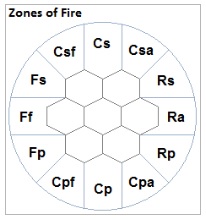Hoshiko Spaceships
Main: Farside Station
Hoshiko International Space Law
Although regional specific rules will vary somewhat from territory-to-territory, there are some general rules which are enforced by all nations. Violation of these rules is considered a criminal offense and are punishable by local law.
- All ships must be registered with a patron nation, providing authorized documentation of the ship’s name, legal ownership, vessel type, base of operations, and crew manifest.
- The operation of a ship, and conduct of captain, crew and passengers aboard the ship, are bound by the regional space laws of both the registered patron nation and those identified on broadcast within the local territory.
- Ships are required to have a functional automatic identification transponder which clearly provides the ship’s registration information and current location when queried by authorized officials.
- When ordered by national authorities, ships must heave to and permit boarding and inspection.
- Ships are forbidden to transit airspace above heavily populated urban areas unless piloted by an authorized agent or harbormaster during arrival or departure maneuvers at a spaceport.
- Ships conducting trade and transport of commodities are required to possess an authorized merchant trade license.
- Ships equipped with external weapon systems, intended for combat actions in defense of the ship, are required to have a valid weapons permit issued by the patron nation.
- Initiating combat with other ships, or engaging in other acts of piracy, are strictly forbidden unless the ship is an authorized agent of the local naval or police forces. Self-protective measures are permitted in defense against acts of piracy.
- Ship and crew are required to provide search, rescue and medical aid to any other ship or crew that is in peril and needs emergency assistance. # Aid must be given without expectation of reward.
- Ship and crew who have rescued and recovered property (lost in space) are entitled to a salvage reward, based on the value of the property and the effort and risk involved recovering the property. If the rightful owner of the property cannot be found (within 30 days) or refuses to pay the salvage reward, the salvors are entitled to claim ownership of the salvage.
Ship Registration: $10,000
Merchant Trade License: $20,000
Weapons Permit: $6,000
Trade Lanes
Core Trade Lanes: the bulk of the freight transport traffic within the Cluster takes place between the Bronceado, Dorado and Latón star systems, however, due to the hinderance and dangers of the asteroid belt el Cinturón de la Nube and the nebular cloud of la Nube at the center, most traffic maintains a standard of travel along established routes. Station Lane: this trade lane is a straight line route from a core star system to the nearest space station, i.e. Dorado to West Point station. These trade lanes average 24.5213 AU in straight line distance. Additionally, there are “halfway” outposts at the 12.26065 AU mark, which offer a Class I spaceport for emergencies and serve as comm relay stations. These lanes are the most heavily patrolled by naval ships, so are the safest from threat of pirate activity. Tri-Lane: this trade lane is a straight line route from a core star system to another core star system (or a space station to another space station), i.e. West Point station to East Point station. These trade lanes average 42.4614 AU in straight line distance. The lanes between the star systems also have “halfway” outposts at the 21.2307 AU mark; 12.26065 AU from nearest space station and only 2.99755 AU from the outer edge of el Cinturón de la Nube. These lanes are only lightly patrolled by naval ships, so have a greater risk from pirate activity.
Cross Transits: aka. “a suicide run”, is not an established trade lane but is a straight line shot from a star system to the space station directly opposite, or any attempt to travel through la Nube. The straight line distance averages 49.0426 AU. Note: although some boastful pilots have made claims to have succeeded at a cross transit, there has never been a validated, confirmed, documented success; in fact, the only reports of cross transit attempt are of ship lost and never again seen. These routes are never patrolled and aside from the general danger of el Nube, pirate activity is especially common in the el Cinturón de la Nube area.
Outland Trade Lane: this is a generally used term to refer to transits from core star systems to the La Forja and El Ascua systems. Due to the ever changing angles and distances between these outer star systems and the core star systems, there is no established trade lane. Space travel to the outlands generally flows from the nearest core system or space station, which serves as a temporary hub for ships from other core systems and stations. Nearest distance to La Forja is 37.9268 AU. When El Ascua is further out, most transit will first stop off in the La Forja system (an “Outland FA” run). When El Ascua is closer in, 25.0729 AU at the closest, most transit will use this as a stopping point before continuing on to La Forja (an “Outland AF” run). This trade lane is only lightly patrolled by naval ships. There is also a “halfway” outpost that holds a position on a straight line from La Forja to the core center point, at a distance of 42.4723 AU.
Farthest Transit Distance: 118.2759 AU, from Bīngèr (moon of Qìtǐyún in the Bronceado system) to BG-3 (moon of Bol'shoy Gaz in El Ascua) when at their farthest possible positions. Note: when at their closest distance, these two destinations are only 6.6203 AU apart!
Ship Types
| Britannia - Hibbert Shipwright | ||||
Bloodhound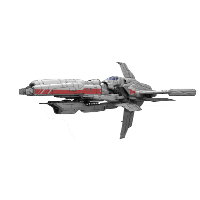 Light Fighter, 56’ long (SM+5) |
Bulldog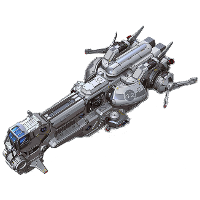 Heavy Gunship, 194’ long (SM+8) |
Great Dane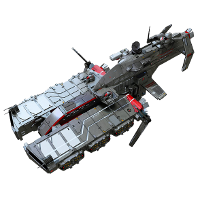 Carrier, 2174’ long (SM+15) |
Husky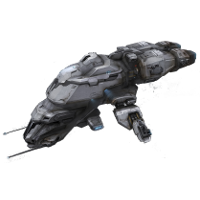 Fast Transport, 58’ long (SM+6) |
Mastiff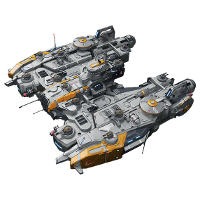 Battleship, 856’ long (SM+13) |
Pinschier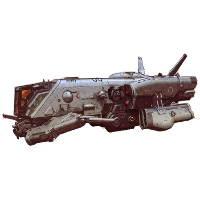 Light Gunship, 122’ long (SM+7) |
Pug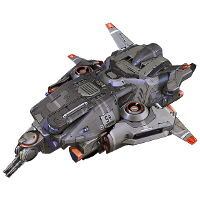 Dropship, 37’ long (SM+5) |
Raven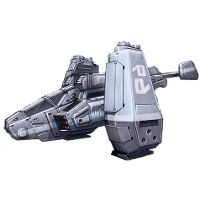 Assault Ship, 32’ long (SM+4) |
Rottweiler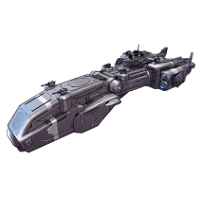 Freighter, 316’ long (SM+10) |
|
| Latónnia - Dura-Acero Industries | ||||
Condor (cóndor)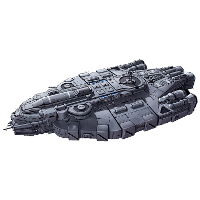 Freighter, 138’ long (SM+7) |
Eagle (águila)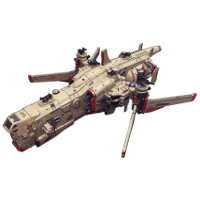 Heavy Gunship, 160’ long (SM+8) |
Falcon (halcón)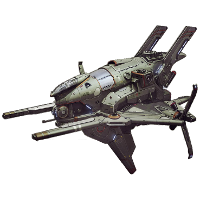 Light Gunship, 92’ long (SM+7) |
Klunker (barcazaa) File:L Klunker.png Mining Barge, 216’ long (SM+9) |
Prospector File:L Prospector.png Survey Ship, 54’ long (SM+6) |
Shuttle (lanzadera)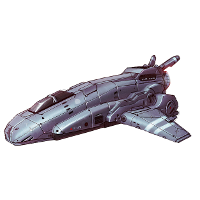 Light Fighter, 42’ long (SM+5) |
Sparrowhawk (gavilán)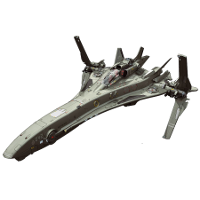 Light Fighter, 58’ long (SM+5) |
|||
| Zhōngguó - Xiaojian Industries | ||||
Dragon(lóng)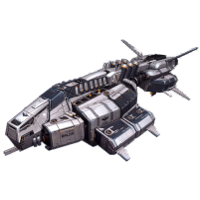 Heavy Gunship, 182’ long (SM+8) |
Phoenix(fènghuáng)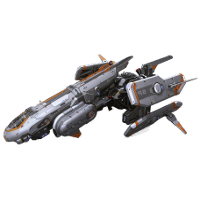 Heavy Fighter, 60’ long (SM+6) |
Pillbug (jiǎchóng)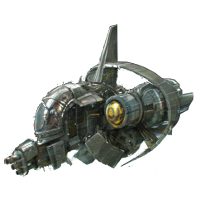 Tug, 26’ long (SM+4) |
Tiger(hǔ)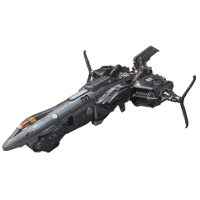 Light Fighter, 52’ long (SM+5) |
Turtle(guī)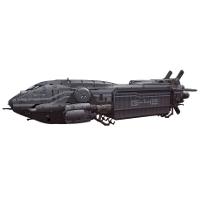 Freighter, 78’ long (SM+6) |
Ship Components
Most any component listed in the Spaceships manual that is TL9 or less is available, but for the special purposes of this game, following are some customized components.
Artificial Gravity
Spacecraft may have artificial gravity generators that create a gravity field that can be varied from 0 to 2G. Artificial gravity may be set individually for each hull section, and, in habitats or work spaces, for each room (from within the room). This permits the crew to shut down an individual zone, such as in one cargo hold, to facilitate moving especially heavy cargo. Crewman make use of magnetized boots when working in zero-g sections. Most space stations and outpost make use of artificial gravity generators to maintain a standard 1.0G for the habitat sections.
Emergency Escape Capsules (EECs)
Also referred to as “life pods”, ships can be designed to include any number of pods, available for the crew and passengers of the ship to use to safely abandon a ship in space during an emergency. Each pod has sufficient space for one SM+0 individual and provides 8 hours of life support. Pods are equipped with emergency transponder beacons to facilitate search and rescue. Cost: $50,000 each. For the additional cost of $25,000 each, pods can be equipped with an automated atmospheric parachute reentry function that will safely land life pods on a nearby planet surface (only if launched from the ship while in orbit).
Hywel Engine
A TL9^ reactionless maneuver drive engine, developed by Gail Hywel in 2071, that allows the vessel to accelerate without using reaction mass. Top speed is near-lightspeed (“near c”), but each engine is also a high-energy system that requires one Power Point while in operation. Manufactured by two separate companies--Masako Dynamics and Hibbert Shipwright--there are six models available, from an affordable low-performance type up to an expensive high-performance type.
- HSC-2416-HE-2 / 0.1 G / Cost: as Standard Reactionless * 0.25
- HSC-2527-HE-4 / 0.3 G / Cost: as Standard Reactionless * 0.75
- HSC-2586-HE-5 / 0.5 G / Cost: as Standard Reactionless * 1.50
- MD-2481-HE-6 / 0.2 G / Cost: as Standard Reactionless * 0.5
- MD-2555-HE-9 / 0.4 G / Cost: as Standard Reactionless
- MD-2632-HE-11 / 0.6 G / Cost: as Standard Reactionless * 2
NOTE: engines can be mounted in [center] hull sections when the engines are mounted on wings or lateral mounts, in which case the engine trust may be directed downward for vertical takeoff.
iCPT Fuel
Iso-cobalt polytitanium argon aerogel (iCPT), aka. “C-Gel” or “Blue Jet”, is a fissionable cobalt isotope suspended in a titanium polymer and argon aerogel. The gel is in a highly stable, minimally toxic, easily transportable form, which combined with its high potential energy output, has helped it become the primary fuel for power plants on modern heavy vehicles and space ships. Manufactured by Banthis Chemicals, a subsidiary of Sylverton Technologies, the gel is distributed in canister cartridges (“fuel cells”) or pumped into fuel tanks (“bunkers”).
Average market value: $750 per ton
iCPT Canisters
| Model | Weight (tons) | (lbs) | Volume (L) | Dimensions (D by L) |
| D-18S | 0.01053 | 21.06 | 18 | 9” x 19” |
| D-50J | 0.02925 | 58.5 | 50 | 12” x 29” |
Refueling Time: Either at spaceports, or for ship-to-ship transfers, large hoses and high powered pumps are used to fill bunkers. Each hose is operated by three crew and fuels at a rate of 1 ton per minute. Large ships require many hoses to fill their especially large bunkers.
Smuggler’s Hold
This is a special cargo hold specifically designed to conceal the contained cargo from detection by remote scanners or close inspection. Provides a bonus of +4 to Smuggling skill roll. Gives the appearance that the section of ship is comprised of mundane internal electronics, conduits, etc. for standard ship components. The hold capacity is 2/3 the normal capacity for a basic cargo hold. Cost: $5,000 per ton. Discovery of a smuggler’s hold by authorities will result in this cargo space being noted in the ship’s registry, providing no future smuggling benefit if the inspection team reviews the ship’s records prior to conducting an inspection.
Vortex Reactor
A TL9 nuclear fission reactor power plant fueled by C-Gel. Each system can provide up to 2 Power Points. When only generating 1 Power Point, fuel is consumed at a half rate. Manufactured by Masako Dynamics, there are three models available, from an affordable low-performance type up to an expensive high-performance type.
- MD-2463-VR-17 / 0.000250 (4,000 hour/tank/PP) / Cost: as Fission Reactor * 0.25
- MD-2522-VR-21 / 0.000125 (8,000 hour/tank/PP) / Cost: as Fission Reactor
- MD-2607-VR-26 / 0.000083 (12,000 hour/tank/PP) / Cost: as Fission Reactor * 4
Weapon Systems
| Weapon Type | Dmg. Type | Acc | Rcl |
| Laser | burn | 0 | 1 |
| Conventional Gun, 20-60mm | cr, ex | -6 | 3 |
| Conventional Gun, 70mm-14cm | cr, ex | -5 | 4 |
| Conventional Gun, 16cm+ | cr, ex | -4 | 5 |
| Railgun, 20-60mm | cr, ex | -3 | 2 |
| Railgun, 70mm-14cm | cr, ex | -2 | 3 |
| Railgun, 16cm+ | cr, ex | -1 | 4 |
| Missiles | cr, ex | 0 | 1 |
- All weapon types have an Armor Divisor (2). Ballistic rounds can be configured for proximity detonation: +4 to hit, Armor Divisor (1).
- Lasers and Railguns are a high-powered systems, requiring 1 PP per weapon system.
- Railgun ammunition weighs 1/2 conventional ammo.
Rate of Fire & Rapid Fire Weapons
| Weapon Configuration |
RoF | Beam Output |
Gun Caliber |
Gun Shots |
Classification | Notes |
| Standard | 3 | 100% | 100% | x1 | Mk I | |
| Improved | 6 | 100% | 100% | x1 | Adv. Mk I | |
| Rapid Fire | 30 | 10% | 50% | x5 | Mk II | [1] |
| Improved, Rapid Fire | 60 | 10% | 50% | x5 | Adv. Mk II | |
| Very Rapid Fire | 300 | 1% | 25% | x20 | Mk III | [2] |
| Improved, Very Rapid Fire | 600 | 1% | 25% | x20 | Adv. Mk III |
- SM+6 or larger ships only*
- SM+7 or larger ships only*
(*) Smaller ships can equip if weapon is increased in size using multiple platforms.
| Ballistics | Beams | ||||
| Caliber | Damage | Weight | Output | Damage | |
| 20mm | 1dx7 | 0.00025 | 1 KJ | 2d | |
| 25mm | 1dx8 | 0.0005 | 5 KJ | 1dx4 | |
| 30mm | 1dx9 | 0.000625 | 10 KJ | 1dx6 | |
| 35mm | 1dx10 | 0.000833 | 50 KJ | 1dx8 | |
| 40mm | 6dx2 | 0.00125 | 100 KJ | 1dx10 | |
| 50mm | 7dx2 | 0.0025 | 500 KJ | 1dx12 | |
| 60mm | 5dx3 | 0.005 | 1 MJ | 1dx14 | |
| 70mm | 6dx3 | 0.008 | 5 MJ | 1dx16 | |
| 80mm | 7dx3 | 0.0125 | 10 MJ | 1dx18 | |
| 90mm | 6dx4 | 0.025 | 50 MJ | 1dx20 | |
| 10cm | 9dx3 | 0.0333 | 100 MJ | 1dx25 | |
| 12cm | 6dx5 | 0.05 | 500 MJ | 1dx30 | |
| 14cm | 6dx6 | 0.0625 | 1 GJ | 1dx35 | |
| 16cm | 6dx7 | 0.1 | 5 GJ | 1dx40 | |
| 18cm | 6dx8 | 0.2 | 10 GJ | 1dx45 | |
| 20cm | 5dx11 | 0.3333 | 50 GJ | 1dx50 | |
| 24cm | 7dx9 | 0.5 | 100 GJ | 1dx60 | |
| 28cm | 6dx12 | 0.625 | 500 GJ | 1dx70 | |
| 32cm | 6dx14 | 1 | 1 TJ | 1dx80 | |
| 40cm | 6dx16 | 2 | 5 TJ | 1dx90 | |
| 46cm | 7dx16 | 4 | 10 TJ | 1dx100 | |
| 52cm | 6dx21 | 7.5 | 50 TJ | 1dx120 | |
| SM+4 | SM+5 | SM+6 | SM+7 | SM+8 | SM+9 | SM+10 | SM+11 | SM+12 | SM+13 | SM+14 | SM+15 | |
| HP | 150 | 200 | 300 | 500 | 700 | 1000 | 1500 | 2000 | 3000 | 5000 | 7000 | 10000 |
| DR, Lgt Alloy | 24 | 40 | 60 | 100 | 140 | 180 | 240 | 300 | 360 | 420 | 500 | 580 |
| DR, Mt Lam | 30 | 60 | 100 | 140 | 180 | 240 | 300 | 360 | 420 | 500 | 580 | 660 |
| DR, Adv Mt Lam | 36 | 100 | 140 | 180 | 240 | 300 | 360 | 420 | 500 | 580 | 660 | 760 |
| Laser Output | 1 MJ | 5 MJ | 10 MJ | 50 MJ | 100 MJ | 500 MJ | 1 GJ | 5 GJ | 10 GJ | 50 GJ | 100 GJ | 500GJ |
| Laser Damage | 1dx14 | 1dx16 | 1dx18 | 1dx20 | 1dx25 | 1dx30 | 1dx35 | 1dx40 | 1dx45 | 1dx50 | 1dx60 | 1dx60 |
| Laser Avg. Dmg. | - | 49 | 56 | 63 | 70 | 88 | 105 | 123 | 140 | 158 | 175 | 210 |
| Gun Caliber | 50mm | 60mm | 70mm | 80mm | 90mm | 10cm | 12cm | 14cm | 16cm | 18cm | 20cm | 24cm |
| Gun Damage | 7dx2 | 5dx3 | 6dx3 | 7dx3 | 6dx4 | 9dx3 | 6dx5 | 6dx6 | 6dx7 | 6dx8 | 5dx11 | 7dx9 |
| Gun Avg. Dmg. | - | 53 | 63 | 74 | 84 | 95 | 105 | 126 | 147 | 168 | 193 | 221 |
| Missile Size | 10cm | 12cm | 14cm | 16cm | 18cm | 20cm | 24cm | 28cm | 32cm | 40cm | 46cm | 52cm |
| Missile Damage | 9dx3 | 6dx5 | 6dx6 | 6dx7 | 6dx8 | 5dx11 | 7dx9 | 6dx12 | 6dx14 | 6dx16 | 7dx16 | 6dx21 |
| Missile Avg. Dmg. | - | 105 | 126 | 147 | 168 | 193 | 221 | 252 | 294 | 336 | 392 | 441 |
| Workstations | 0 | 0 | 0 | 0 | 0 | 0 | 1 | 3 | 10 | 30 | 100 | 300 |
| Uninstalled Cargo (ea.) | 0.05 | 0.15 | 0.5 | 1.5 | 5 | 15 | 50 | 150 | 500 | 1,500 | 5,000 | 15,000 |
| Cost (ea.) | 5K | 15K | 50K | 150K | 500K | 1.5M | 5M | 15M | 50M | 150M | 500M | 1.5B |
NOTES
- Every weapon system contains 10 weapon mounts.
- Each weapon mount can hold one weapon platform of the appropriate size (Fixed or Turret).
- Each gun platform has a base 30 Shots; reload rate of RoF per turn.
- Each missile platform holds 5 Shots; reload rate of 1 per turn.
- Beams have unlimited Shots and do not require reloading, however, they are a high-power system, requiring 1 PP per system.
- For every 10 points of damage absorbed by armor, reduce the DR by 1 point. If the armor is reduced to 0 DR, the armor is destroyed.
- A weapon platform can support larger weapons, sacrificing 1 weapon mount per each 1 level increase in size, i.e. a SM+7 ship could use 3 of 10 weapon mounts to support one 10cm gun instead of having three 80mm guns.
- Fixed: +2 to hit, fixed facing. Turrets: increased arc of fire.
- Weapon platform can be located in any section of the ship, regardless of which section the weapon system is located.
- Zone of fire is based on platform location and angle of fire designated for fixed, i.e. a fixed gun in front section, port side.
- Zones: front-front, front-port, front-starboard, center-front, center-port, center-rear, center-starboard, rear-rear, rear-port, rear-starboard. Fixed can fire in one zone only. Turrets can cover three adjacent zones.
- Lasers & guns are LC3. Missiles are LC2.
- Upgrades for rapid fire, improved and electromagnetic are available.
- Salvaged weaponry that is not destroyed can be installed on any free mount.
- Every weapon system contains 10 weapon mounts.
- Each weapon mount can hold one weapon platform of the appropriate size (Fixed or Turret).
- Each gun platform has a base 30 Shots; reload rate of RoF per turn.
- Each missile platform holds 5 Shots; reload rate of 1 per turn.
- Beams have unlimited Shots and do not require reloading, however, they are a high-power system, requiring 1 PP per system.
- Any damage absorbed by armor is applied to armor system HP.
- A weapon platform can support larger weapons, sacrificing 2 weapon mounts per each 1 level increase in size, i.e. a SM+7 ship could use 3 weapon mounts to support one 90mm gun and 7 weapon mounts for a 10cm gun, instead of having 10 x 80mm guns.
- Fixed: +2 to hit, fixed facing. Turrets: increased arc of fire.
- Weapon platforms can be located in any section of the ship, regardless of which section the weapon system is located.
- There are a total of twelve 30-degree zones of fire around a ship, based on the hull section and firing direction for each weapon platform.
- Hull Sections: Front (F), Center (C), Rear (R)
- Firing Directions: Fore (f), Port (p), Starboard (s), Aft (a)
- Fixed weapons can fire at targets only in their zone of fire, i.e. a fixed gun mounted in zone Cs can only fire at targets in zone Cs.
- Turret can fire within their zone of fire plus the adjacent zone to the left and right, i.e. a turret mounted in zone Cs can fire at targets in zones Csf, Cs and Csa.
Ammunition Types
- High Explosive (HE): standard warhead, Armor Divisor (2). Optional proximity detonation gives +1 to hit, Armor Divisor (1). Cost: $40,000 per ton.
- Armor-Piercing Hard Core (APHC): Armor Divisor (3). Cost: $80,000 per ton.
- Armor-Piercing Discarding-Sabot (APDS): Armor Divisor (3), +1 damage per die. Cost: $200,000 per ton.
- Armor-Piercing Enhanced Penetrator (APEP): Armor Divisor (5). Cost: $200,000 per ton.
- Armor-Piercing Hardcore Explosive (APHEX): Armor Divisor (3) & follow-up damage to ship systems. Cost: $400,000 per ton. 100mm 8d cr ex [5d]
- Biochemical Aerosol: follow-up release of airborne chemical agent to effect crew. Cost: $80,000 per ton.
- Shredders: Armor Divisor (0.5), follow-up damage designed to target crew. Cost: $40,000 per ton.
Weapon Naming Method
The weapon systems for space ships are manufactured by five different companies, one for each nation. Each company produces a conventional gun, electromagnetic gun, laser and missile. These weapon system are named as follows:
[manufacture] [advanced (if applicable)] [nation/type name] [output/caliber] [fire type] For missiles, the warhead type is included instead of fire type.
| Arabian | British | Chinese | Laton | Russian | |
| Manufacturer | Ghanem | Walker | Huiliang | Barrios | Moroshkin |
| Gun | Hilal | Sledgehammer | Han Xin | Salazar | Budyonny |
| Railgun | Lokman | Mauler | Monk Ji Gong | Hidalgo | Kozhedub |
| Laser | Iskandar | Cutlass | Mulan | Juarez | Zhukov |
| Missile | Babadur | Javlin | Yue Fei | Cuauhtemo | Brezhnev |
- Adv. (advanced = improved)
- Mk I (standard)
- Mk II (rapid fire)
- Mk III (very rapid fire)
- Turret (T)
Example: Walker Mauler T 10cm Mk II … Barrios Adv. Juarez 50MJ Mk I … Ghanem Babadur 16cm APHC
Reloading depleted shots requires crew to manually load new rounds of ammunition into the weapon system. The number of crew members needed equals 1 per ton of ammo (min 1). The quantity loaded each round of action is equal to the RoF of the weapon.
Zones of Fire
Weapon platforms can be located in any section of the ship, regardless of which section the weapon system is located.
There are a total of twelve 30-degree zones of fire around a ship, based on the hull section and firing direction for each weapon platform.
Hull Sections: Front (F), Center (C), Rear (R) Firing Directions: Fore (f), Port (p), Starboard (s), Aft (a)
Fixed weapons can fire at targets only in their zone of fire, i.e. a fixed gun mounted in zone Cs can only fire at targets in zone Cs.
Turret can fire within their zone of fire plus the adjacent zone to the left and right, i.e. a turret mounted in zone Cs can fire at targets in zones Csf, Cs and Csa.
Communications
There are two forms of communication used by ships in space: standard radio wave and tightbeam laser. Radio is a broadcast method that expands outward in all directions and can be monitored by anyone listening. Lasers are pinpoint accurate, targeting a single contact, which unauthorized monitoring almost impossible. Both forms of communication often make use of encryption to keep conversations private.
They both travel at the speed of light: 299,792,458 m/sec or 0.002 AU/sec. For example, a message sent from West Point Station to Farside Station (42.472137 AU) would take 21,236 seconds, or 5.9 hours.
Very Low Frequency (3 - 30 kHz)(slow data transfer/military use) Low Frequency (30 - 300 kHz)(low band comms, AM broadcast) Medium Frequency (300 kHz - 3 MHz)(navigation beacons and ship-to-ship comms) High Frequency (3 - 30 MHz)(shortwave radio) Very High Frequency (30 - 300 MHz)(FM broadcast, TV range, military comms) Ultra to Extremely High Frequency (300 MHz - 300 GHz)(microwaves, data transfer)
Radio bandwidths have special ranges reserved for government and military use. A civilian or commercial ship broadcasting on these frequencies is illegal.
There is one general “emergency band” radio frequency 2.5 MHz, which all civilian and commercial ships are expected to monitor for emergency communications.
The 5.4 MHz frequency is the “rogue wave emergency alert network”.
Due to the Cluster’s presence in the Hoshiko Nebula, there is constant flow of nebula dust and gases that drift slowly throughout the cluster. This affects communications, creating “static” and reducing the effective range; -1 to skill roll per range increment: Laser increment: 0.5 AU, with no comm beyond 5.0 AU Radio increment: 4.0 AU, no max range
Comms through La Nube are impossible. Within La Nuba, laser range increment is in yards and radio to 100 yards.
Radio relay beacons have been positioned at various places in the system, along with on all space stations, to facilitate long range communications.
Government/military installations, spaceports and very large ships employ very powerful boosters to extend radio comms by x10; use of boosters by civilian/commercial ships is outlawed.
Electronics Operations (comm) skill rolls made to receive a communication get a bonus equal the the ship’s comm level and a penalty for the distance which the signal travelled.
Ship Repairs & Maintenance
Each component system on a ship can incur damage, either due to damage in combat or wear-and-tear through use. Having a component at less than 80% opens up the possibility of a malfunction during operation.
Malfunction Score: (20 x condition%) + 2, to a minimum of 5.
The current value of a component is equal to the base cost times the condition percentage. This affects the overall value of a ship and determines what the base cost would be to buy/sell it.
Material Costs: 0.0025 x base cost (minimum of $1) per 1% of repairs. Must have materials already on hand or be at a proper facility to buy them. Salvaged parts reduce material costs by half. If the parts were successfully salvaged without damaging the parts (same skill required to salvage parts as needed to repair that system). Not what ship system the parts were part of. Each portion of parts needed for 1% repairs Complete replacement of a component with a salvaged component requires no additional material costs, but only provides current condition of the salvaged part.
Parts & Materials
In order to make repairs to ship systems, the mechanic will require parts and materials (“parts”), which must be on hand prior to making repairs. The cost of the parts is calculated upon the “new price”, or base cost, of the specific ship system. Although most spaceports have shops available to sell parts, there may be occasions that repairs need to be made when the ship is nowhere near such a port, so a well prepared crew will make sure to have a small stockpile of parts for use for emergency repairs, whereas a resourceful crew will always make sure to salvage parts from ship wreckage or captured prize ships.
Parts are purchased, or salvaged, stored and used as a unit. The cargo weight of each unit is based on the size of the ship: load weight x 0.00005. Each unit is designated (labeled) for a specific ship system, so they are not interchangeable.
New Part Cost: [ship system base cost] x 0.0025, per unit, minimum $10 Salvage Part Cost: none
Salvaging Parts & Materials Each salvaging attempt takes 1 hour and requires a successful skill roll, using the same skill as the one required to fix the specific ship system.
, just requires skill check for successful salvage (same skill as that needed to repair the ship system).
Each attempt to make repairs takes 1 man hour and requires the specific skill appropriate for the component to be repaired. A success restores a number of HPs equal to the margin of success (+1). A critical success restores double the amount, but only for half the material cost. A critical failure damages the component by 1d HP and wastes 1% worth of materials. Each mechanic working makes an individual skill roll. Maximum of one mechanic per ship system, plus one per available workstation.
Access to a “dry dock” facilities at a spaceport provides a +1 bonus per class of port (1-5) to the roll, but at a cost of $100 per hour per port class.
Certified Mechanic Shops
Hiring a 3rd party (a ship mechanic shop) to make the repairs will generally provide a better guarantee of success, but at a cost. They will provide an estimate for the requested repairs, calculated at 6% (+1 per spaceport class) repaired per man hour, at $30 per man hour plus Material Costs.
Mechanic shops get the same bonus for “dry docks”, but at the additional cost.
Results of the repairs are based on the quality of the mechanic shop; make a Reaction Roll to determine (-2 for Class I port, -1 for Class II port, +1 for Class VI port and +2 for Class V port): Disastrous: they hold onto the ship for the full time, appear to be working, but don’t actually make any real repairs; still charge the full amount; lie that job was completed as quoted--a Detect Lies or an inspection with Mechanic (spaceships) will reveal the deception. Very Bad: the shop does bad work and will lie about it, as with Disastrous, but will make some repairs; -4% per man hour. Bad: the shop will contact owner several times to explain that unexpected problems were found that alter what was originally quoted; -2% per man hour. Poor: same as Bad, but at -1% per man hour. Neutral: repairs made as quoted. Good: repairs made slightly faster than quoted; +1% per man hour. Very Good: repairs made faster than quoted; +2% per man hour. Excellent: repairs made much faster than quoted; +4% per man hour.
Ship Combat
Ship combat rounds are 1 minute turns. A 1.0 G acceleration = 600 yards/minute. A map hex = 60 yards, so a ship’s MV score is equal to acceleration (G) / 0.1, i.e. a 0.8 G acceleration is MV 8. A “close” attack is at a range of 30 yards (no less); this is essentially a point-blank-shot. Each system on a ship has HP equal to 10% of the ship’s HP, ie. the engine room on a SM+7 ship will have 50 HP. The condition of a system is a percentage of current HP, ie. if the engine room has sustained 12 damage, the system currently has 38 HP so is at 76% condition. Malfunction score of a ship component is based on the current condition. Malf = 20 * cond% (min 5 unless destroyed). Any damage dealt to a system sufficient to reduce the HP to zero “disables” the system. Any remaining damage from that attack is wasted. Additional attacks to that system will instead carry through to the next intact system. After combat has been completed, a HT roll must be made for each “disable” system. If the roll fails, the system was “destroyed”. Disabled systems can be repaired; destroyed systems cannot. Damage that strikes armor systems of ship has total damage reduced by DR as normal, then any remaining damage is applied to the armor system HP. Once the armor system is reduced to 0 HP (destroyed), then all other systems in that hull section are at 1/2 DR. Also, any further hits the the armor system automatically bypass armor and apply full damage to next non-destroyed system. Personal combat onboard a ship can result in damage to the ship. Any firearm attacks that miss the target foe, or foe in line of fire, will inflict damage on the section of ship in which the combat is taking place.
Combat Turn Crew Actions
Each PC or important NPC identifies which action they are going to make (if any) each turn.
Multitasking: -2 per additional task (in same category), or -4 per additional task (from different category).
Command Tasks Leadership: Leadership roll; provides a +1 for subordinate(s) morale and self-control checks. Success by 5+ (or critical) also gives a +1 Spacer skill for (subordinates) Motivate Crewman: Shiphandling roll; +1 to all skills for a single subordinate; -1 with failure or -2 with crit fail. Shiphandling: Pilot can substitute the lower of Spacer skill or leader Shiphandling for Piloting skill. Space Tactics: predict single enemy actions, using lower Navigation (Space) or Tactics+1. "offensive tactics": gives a -1 Dodge to target’s defense. "defensive tactics": provides a +1 Dodge vs. target attacks.
Piloting Tasks Move Maneuver: any normal "piloting maneuver", changing course, acceleration, or especially to avoid obstacles. Piloting-3 roll when navigating dense asteroid fields. Evasive Action: Piloting skill to jig ship to give +1 Dodge; course and acceleration remain constant. Other Actions: robotic arms or external clamps.
Engineering Tasks Allocate Power: reassign power points to different components. Increase Power: Electrician skill roll provides one extra power point for turn; critical fail cause overload (PP x 1/2 for turn). Damage Control: appropriate Repair skill for power plant to get double PP for turn. Emergency Repairs: Repair-9 skill to jury rig, restoring a malfunctioned system to use. Halt Catastrophe: for an engineer only, Repair skill to prevent explosion of a damaged volatile system.
Navigation & Communication Tasks Tactical Navigation: lower of Electronics Operation (Sensor) or Navigation (Space) skill; gives +1 to pilot's Piloting skill for turn. Failure by 4+ has -1 to Pilot's skill (crit fail -2). Sensor Detection: roll “detection” for each un-detected object. Sensor Analysis: attempt analysis of sensor data, revealing details (critical success gives additional detail, critical failure give misinformation). Engineering Analysis: Engineer (Spaceships) skill. Add +3 if your sensors incorporated a multiscanner. Success reveals basic system types of all six hull systems on the facing hull section Identifies if system is functional, disabled or destroyed Core systems cannot be seen, details of system types not revealed, just type Critical Success or success by 5+ reveals weak points Bio Analysis: requires multiscanner, roll vs. Biology skill Determine number, and location, of all lifeforms aboard vessel Supervise Damage Control: lower of Electronics Operation (Comms) or Spacer skill. Success adds a +1 bonus to that team’s damage control rolls this turn (+2 on a critical success). Failure has no effect; critical failure means you distract them: a -1 penalty. Can only be performed once per party. Signal Enhancement: Electronics Operation (Comms) roll to interpret weak, garbled, or static-filled message. Quick Contest vs enemy Electronics Operation (Electronic Warfare) if jamming Signal Jamming: with tactical or multipurpose array, Electronics Operation (Electronic Warfare), 1% of communication range.
Gunnery Tasks Gunnery crew are tasked with reloading weapon systems as well as handling targeting and firing controls. Attempts to reload & attack targets, or attacking multiple targets, is a multi-task if done by a single crew member. Artillery (Guided Missile) for missiles Gunner(Cannon) for guns Gunner (Beam) for beams Aim and Attack: All-Out (Deliberate) Attack Wait (Aim and Attack): delayed attack on enemy ships. Wait (Point Defense): target incoming missile attacks.
Damage Control General damage control efforts that can be made by any crew member. Emergency Repairs: Repair-9 skill to jury rig, restoring a malfunctioned system to use. Rescue: Spacer-3 skill to rescue survivors from destroyed systems. Fire Control: Spacer-1 skill to control and extinguish fire in a damaged system. Repair Hull Breach: damage that penetrates into habitat sections, or occupied systems, will create a breach in the hull, exposing ship to vacuum. Spacer-2 skill to apply emergency patch to seal the breach.
Detection & Sensor Analysis
Before a ship can engage an enemy ship, outpost or other object, the target must first be detected.
Passive Sensors The standard comm/sensor array include telescopes (visual, infrared, ultraviolet, radio) for navigation, detection, and targeting. They include Telescopic Vision with same level as the level of the comm/sensor array. Passive sensors can also detect and locate any operating active sensor or broadcast signal within twice its own range.
Active Sensors The standard comm/sensor array consists of radar and ladar used for navigation, detection, and targeting. Primary use is not for detection, but for target tracking, mapping and detailed ship analysis.
Electronics Operation (Sensors)
Target Detection (Active Sensors) Active sensors in a comm/sensor array consist of radar and ladar used for short-range navigation, detection, and targeting. Their range is measured in light seconds (one light second is 186,000 miles), based on the level of the sensor array of the ship. A radar/ladar “ping” is emitted from the array, with timed delay in echo response used to identify target location. These radar/ladar transmission can be sensed by enemies, so use of active sensors is not recommended for stealth actions.
Target Detection (Passive Sensors) Comm/sensor arrays include telescopes (visual, infrared, ultraviolet, radio) for navigation, detection, and targeting. The operator uses Electronics Operation (Sensors) skill. Detect and locate operating active sensors at twice range.
Modifiers Size of target: SM Range (per pg. B550) Telescopic Vision: Reduce the above range penalty by the level of Telescopic Vision. You may “zoom in” and use twice the Level if the target’s approximate location is already known. Observation: +10 if object is in plain sight In Space: +2 if the object is silhouetted against a larger celestial body, +24 if silhouetted against deep space. Note that this is cumulative with the plain sight modifier. IR Signature: Spacecraft often put out a lot of heat and light! If trying to detect a spacecraft or similar object, apply the single highest applicable modifier: Minimal power: 0*. Auxiliary power: +3. Fuel cell, solar panels, or jet engine: +4 MHD turbine, chemical or HEDM rocket engine, or flying in atmosphere at 3,600+ mph: +5 Fission reactor, nuclear thermal rocket, nuclear light bulb, or performing a high-speed atmospheric reentry: +6. Antimatter thermal rocket engine, antimatter reactor, fusion reactor, super fusion reactor, total conversion reactor, magsail, lightsail: +7. Fusion pulse drive or fusion rocket engine: +8. Advanced fusion pulse, antimatter plasma, nuclear saltwater rocket, or external pulsed plasma engine: +9. Antimatter plasma torch, antimatter pion, or fusion torch engine: +10. Antimatter pion torch, super antimatter plasma torch, or total conversion torch engine: +11. Super conversion torch engine, or any “cosmic” power plant: +12.
Critical Failure False information received.
Failure: no contacts Critical Failure: possible false contacts Success: detection of object, range, course, temperature class and SM, but no other details.
Detection Success
Success means detection of the object’s presence. Once an object is detected the sensors will automatically keep track of it (along with anything it launches). It remains detected as long as it remains in line of sight. Information identified with detection:
Size and mass.
Range, course and acceleration.
Temperature class and type of maneuver drive (if the spacecraft accelerated).
Sensor Analysis Once an object has been detected, additional scanning and analysis of the data may reveal additional and more detailed information about the object. Engineering Analysis: Roll against your Engineer (Spaceships or Starships) skill. Add +3 if your sensors incorporated a multiscanner. Success reveals the basic system type (e.g., “habitat” or “chemical rocket engine”) of all six hull systems [1-6] on the hull section facing your vessel, and whether they are functional, disabled, or destroyed. Only the first, outer armor layer’s composition is revealed. Details that vary from system to system are not revealed: you would not know what type of weapon was in a spinal weapon system, or the exact types of cabins in a habitat. Cores systems are hidden. Success by 5+ is required to detect any weak points in the hull that can be targeted. Bio Analysis: If using a multiscanner, you can roll against Biology skill to analyze sensor data and determine number and species (if known) of lifeforms aboard the vessel. This will also reveal the presence of any living systems (gardens, organic hulls, etc.).
Ship Movement
Map Hex: 60 meters; Close Scale Engagement (1-min turn) Map Movement: 1 hex per 0.1 G of ship acceleration Turn Radius: each 60-degree takes 1 movement point, however, a ship can “veer” to either the left or right forward hexes as a free action when moving forward. A ship can “spin” 180-degrees and then thrust to reverse course, but must spend 3 movement points for the reverse maneuver.
NOTE: missiles travel at 1,200 m/sec (120 G), which is 1200 hex per turn. At these extreme speeds, the missile cannot make extreme turns, so has a turn radius of 60 hexes. For any missiles that miss their target, the missiles will circle back around and attempt to reacquire their target. Each missile will get 1 extra pass-through attack (in the next turn) before running out of fuel.
Ship Combat
Multiple Weapons / Multiple Targets If a ship’s weapon system batteries has multiple individual weapon mounts (fixed or turrets) of the same type (gun/laser/missile) and caliber, the gunner has the option to combine all weapons into one single attack (with increased RoF) against a single target or divided the weapon attacks against multiple targets. Weapons must be in line of sight with target, i.e. a fixed gun in the front section could not fire on a target to the sides or rear. When attacking multiple targets, there is a penalty to the attack rolls per each additional target.
Force Screen This shielding is powerful, but is semi-ablative--the dDR value is reduced by 1 for every 10 dDmg absorbed--that recharges at 10% per turn.
Example: a SM+7 heavy force screen at full power has 100 dDR. An attacking dealing 58 dDmg will reduce the dDR to 95. By the following turn, the screen will have recharged by up to 10 dDR, in this case bringing it back up to 100 dDR. Multiple attacks in the same turn can reduce a shield to very low levels, but only sufficient damage targeted specifically at the shield generator will actually disable the shield completely.
NOTE: Force Screen dDR cannot be reduced any lower than 9 dDR, or 18 dDR for weapons with Armor Divisor (2).
Dodge The base dodge skill is (Piloting skill / 2) + Handling value of the ship
Modifiers: Defensive ECM systems: +1 each (max 3) Evasive Maneuver: +1 Command Tactics (Defensive): +1 Ship did not accelerate this turn: -3
Point Defense Guns and lasers held in “wait” can be used to target incoming missiles. Normal modifiers for size and range apply to the attack roll. For each successful hit, the number of incoming missiles is reduced by one. Missiles cannot dodge.
Damage to Systems Attack damage that penetrates through any shielding and armor inflicts damage on the system within the hull section that was targeted; roll 1d to identify specific system hit. Once a system has sustained cumulative damage of at least 10% of the ship dHP, the system becomes “Disabled” and no longer functions. Once a system has sustained damage equal to 50% of the ship dHP (or more), the system is “Destroyed”. After a system has been destroyed, any further attack damage that strikes that location will carry through to the next system in line (i.e. a hit to 5 will go to 6, if 6 is destroyed, it will go to a core system, etc.).
NOTE: if a single attack inflicts greater penetration damage than is needed to destroy the targeted system, the remaining damage of that attack is wasted and does not carry through to other parts of the ship. Only later strikes to the destroyed system will carry through to the next system in line.
Volatile Systems When a Power Plant system sustains enough damage to become disabled, or destroyed, the system must make a HT check (HT-5 if destroyed) or the system will explode at end of next turn, reducing the ship to -10 x dHP (vaporised ship).
Ship Integrity Individual damage applied to all hull section ship systems is summed to find the total damage which the ship has sustained.
Once a ship has been reduced to 0 dHP or less: All comm/sensor array levels are -1. Its Handling is reduced by 2. Its gunners have a -2 to hit when making beam attack rolls.
Once a ship has been reduced to -1 x dHP or worse, the integrity of the ship has been compromised to the point which the ship might become destroyed. Make a HT (-1 per level) check at each level. At -5 x dHP, the ship is automatically destroyed.
